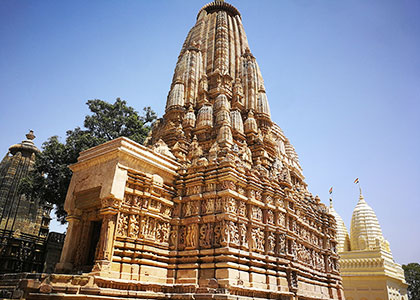Javari Temple, Khajuraho
India is a land of beauty, and sometimes bizarre, monuments. Among these monuments, temples of Khajuraho are by far one of the most well-known structures in the world. The beautiful and sensuous temples of Khajuraho, comprising only ten percent of the entire compound, are a piece of art and are heavily hyped among tourists. This write-up focuses on the Javari or Javeri Temple in Khajuraho that was constructed during the last phase of the 10th or early 11th century. A grand temple, dedicated to Vishnu, is located in the Eastern cluster of Khajuraho. The temple is mostly built per Hindu mandala design, comprising of square and circles, with the inclusion of intricately carved statues decorating the walls of the shrine.Let’s explore the fascinating beautiful Javeri Temple, Khajuraho and uncover some of its fascinating secrets.
Keynote on Javeri Temple, Khajuraho

Javari Temple
|
![]() Type of monument: Temple
Type of monument: Temple
![]() Primary deity: Vishnu
Primary deity: Vishnu
![]() Architectural style: Shikhara style architecture
Architectural style: Shikhara style architecture
![]() Opening time: 8:00 am – 8:00 pm
Opening time: 8:00 am – 8:00 pm
![]() Entry: Free
Entry: Free
![]() Visit Duration: Around 1 hour
Visit Duration: Around 1 hour
![]() Best time to visit: October to November
Best time to visit: October to November
![]() How to Reach: Buses and cars available
How to Reach: Buses and cars available
Overview of the Temple
The Javeri Temple, Khajuraho is located in the Eastern Cluster of the Khajuraho Group of Monuments. Dedicated to Vishnu, as most of the temples in this cluster are, the temple was built around 1100 A.D. The mutilated figure of Vishnu, the primary deity is still standing inside the sanctum sanctorum of the temple. Although, a tiny temple one can find several interesting features like a detailed mandala, an intricately carved arch on the entrance, and various sculptures of Hindu gods and goddesses could be seen here.The Architecture of Javeri Temple, Khajuraho
The architecture of the Javeri Temple in Khajuraho is predominantly Shikhara style architecture. The temple has a rising tower, a common feature in the North Indian temple structure. Heavily decorated spire or Shikhara standing tall garbhagriha chamber or the sanctum, sanctorum is visible from afar. Apart from that, the temple has a heavily decorated vestibule, mandapa, and an elaborate portico.Being a symmetry-driven structure, as most Hindu temples are, the temple has a network of pillars with statues and carvings that represents basic principles of human life according to the Hindu school of philosophy. The walls of the temple are decorated by images of important Hindu gods, including Shiva, Brahma, and Nava-Grahas (the nine planets). One of the most stunning features of the temple is the Capricorn (Makara) Arch.
|
|
|
Visitors can find a mutilated idol of Vishnu, the primary deity, standing inside the sanctum sanctorum. The idol was carved out of a stone and encompasses smaller sculptures.
Makara Arch of Javeri Temple
One of the stunning features of Javeri Temple, the Makara Arch has showcased the height of Indian sculpting and craftsmanship. As the visitors climb the flight of the stairs, they reach the temple gateway and are greeted by this work of art. The Makara arch constitutes of four smaller curves arranged one after another, to form a uniform structure. In the gaps between the individual arches, one can see several smaller sculptures sitting in different poses.The upper section of the arch has minuscule human figurines, sitting over the top of the arch. This creates a symmetrical image, which is quite pleasing to the eye.
Some Important Things to Remember While Visiting Khajuraho
1. The place is one of the most popular landmarks of India, and during the tourist season, the place is crowded with tourists. Visitors interested in exploring the beauty of the palace without touristy crowd are advised to visit the area during the opening hours.2. Khajuraho has a hot and arid climate, with very harsh sun. Therefore, carrying adequate sun protection is always recommended. Visitors are advised to carry sunscreen, hat and proper sunglasses for protecting themselves. Also, drinking plenty of water to stay hydrated is essential.
3. The Eastern Group of temples comprises of Paraswanath temple, Ghantai Temple, Vamana Temple, Adinath Temple, Hanuman temple, and Brahma temple – besides the Javeri Temple, Khajuraho. Each of these temples is a work of art and a must-visit for tourists.


